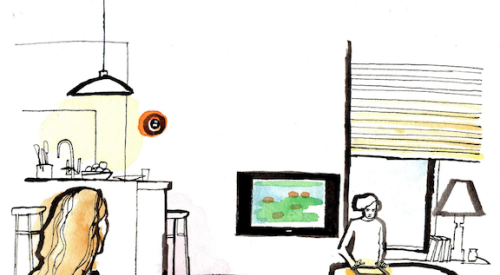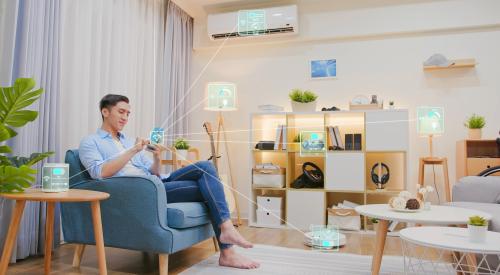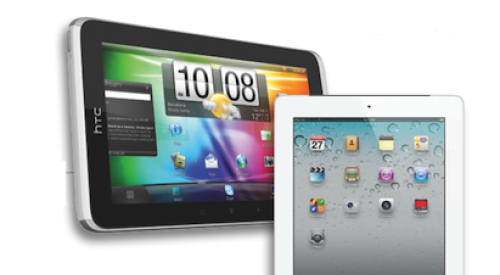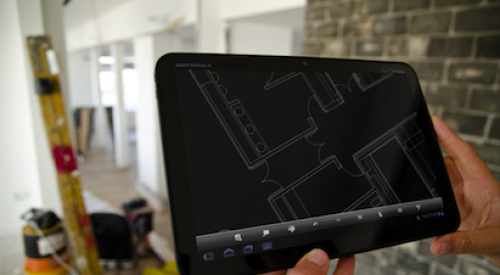| John Picard on the site of his future residence, and his home-technology lab.
|
One of the most challenging aspects of home building today is understanding the implications of the Internet and the myriad of other fast-changing communications technologies. Buyers today expect such things as high speed connections to the Web offered by cable modems or even fiber optics. By the same token, most builder/developers of larger communities are also getting the message that money is being left on the table if a portion of the recurring revenue stream from phone, cable and alarm service to households is not retained through agreements with service providers.
Consultant John Picard of E2 (Environmental Enterprises) Inc. in Manhattan Beach, California is a guru that many of the industry’s largest developers have turned to sort out these issues. Stressing the importance of having good partners, his solutions are lauded for being practical, flexible and well ahead of the curve. On a smaller scale, Picard is building his third in a series of high-tech personal residences. Laden with chip-bearing devices, his newest home will showcase some of his more visionary ideas about how individual home networks hold the promise of, among other things, improving environment.
Professional Builder: One of your goals is to integrate digital and environmental technology. What does that mean?
John Picard: Most of what I have done in the last 10 years is push for high efficiency and environmental systems in the home geared toward sustainability. Then along came the Internet and I started to get the sense that if I did another house, the goal had to be constant communication in the public realm. I began looking at what is possible by applying network efficiency to appliances and anything that uses energy and water -- to look at a home as a machine.
I realized that Smart House and the Home of the Future were hyped as the new Whiz-Bang, like electric windows and color TV. I wanted to approach it as a way to give people the ability to go somewhere in the public domain and find shareware or software that would allow things to communicate. My hope is that I can at least show the beginnings of how information, and visualizing information is as important as putting in all of these static features like recycled steel or bamboo floors.
One of my ideas is to give everything in the house an Internet protocol (IP) address -- security, the real-time temperature, lighting and water usage and all the stuff that you don’t see.
What would be the benefit of giving everything in the home an Internet address?
The benefit would come from doing things like taking my water meter, creating a connectivity point to it and pushing a packet of information back to the utility. I think there is an opportunity there to optimize -- not a great deal of optimization individually -- but collectively. With IP addresses, a house could take in weather conditions and indoor air quality conditions. It could take in purchase-information out on the Net for power and gas and could eventually make buying decisions.
When you are hired by a developer, what exactly are they looking to you for?
My work is staying up on what is happening and perhaps more importantly, what is not happening. I spend as much time going forward and understanding new technology as I do finding out what has not worked in the last six months.
What are some of the things on that list that has not worked?
Things like creating an e-mail service for your planned community from scratch. What’s happening is working cooperatively and going to companies like AOL (America Online) and seeing if there is a fit, or going to other Internet service providers and working with them. The fatalities have been where people have tried to do too much.
Switching over to your work with Playa Vista in Los Angeles, what, from a technology standpoint, will buyers first notice?
The baseline services at Playa Vista are really rich. It is almost like AOL custom for this community and it is just sitting there for free. So they will notice an Intranet that looks like an electronic newsletter. It has an ATM-like menu with lots of practical information grounded in what the community is about, like when the shuttles run and where to shop.
They will also notice that their phone already has a dial tone. If they want, they can go online and change their phone number and change their calling plan. All of the utilities in their house will be switched on.
Is there an Internet appliance of some sort that comes standard in each home?
No, that is not what is planned, but there is a hand-held device. There will be a lot of exciting stuff coming from Sony and Cisco Systems that cannot be fully discussed at this point. Suffice it to say that our technology partners will use cell phones and the wireless environment strongly and exclusively. Eventually, I think that home technology is going to go all wireless. Wireless applications will bring everything together automatically. You won’t even see it.
Any other items worth noting about the technology at Playa Vista?
|
For starters, I think that you will see some very sophisticated energy management. Secondly, Playa Vista has not ignored the fact that television will continue to be the 900-pound Gorilla in the future. They are likely to embrace (software enabled) set-top boxes for the main connection to the Internet as well as for cable and on-demand video.
Another area worth noting has less to do with hardware. They have created this next-level category of services through partnerships with providers of everything from travel services to art consulting. Buyers will quickly realize the amount of work that has gone into it. For example, there will be two or three options within each menu area so they will be able to select services without feeling like they are single-sourcing.
Sounds like a lot of partnering?
It is so much work. The thing that small builders and developers should know is the enormous amount of follow-up that has to be considered when you get ready to embrace this concept of connected communities. They should look at projects like Playa Vista as a vehicle to understand what is possible. Success will come from a builder’s ability to bring in existing businesses and develop relationships with the local schools and universities. Use the local community as an integral part of your communications effort.
What things can builders do that will technologically enable the homes they build without too much risk on their part?
The first thing is don’t limit access to the house, even if it means putting in a blank piece of conduit. Allow access into the home. Don’t worry about whether it is fiber or wireless or Cat5, or DSL or cable modems. Builders tend to get bogged down with hardware decisions. Just get from the street into the house and run a few things within the house that make sense within your floor plan that allows some options for the owner later. It is very hard to pin down this ball of moving opportunities.












